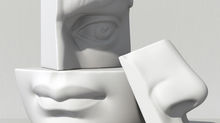Facial Palsy
- Gill Benveniste
- Jul 30, 2019
- 3 min read
Updated: Nov 8, 2020
There are key moments in our lives which define us. Times when we need to find an inner strength like no other. Times which can either make us, or break us. Coming to terms with facial paralysis was one of those moments for me…

With very little warning – just a very painful earache the day before, I woke up one November morning with half a face; one half was totally immobile. After an initial panic that I was having a stroke (I had no idea what else it could have been) I was diagnosed with Bell’s palsy. I had no idea what this was.
Initially I saw the funny side. It was fascinating really, my face looked like a reflection in a distorted circus mirror. I remember joking about it, saying I looked like a gargoyle. But then there was the pain. My neck, chin, ear and cheeks felt bruised and ached continuously and my left eye, which wouldn’t shut at all independently was becoming more and more irritated.
I didn’t want to go out or see people because I was so conscious of the way I looked. The pain and discomfort was constantly draining and I was annoyed I wasn’t at work.
It got to almost three months. I was trying to get back to my work as a Primary School Teacher but felt pretty down. Anxiety had also kicked in, especially when I needed to face people for the first time. However with the support of colleagues and a class of amazing 7 and 8 year old children, I was able to return to work, if at first gradually. A child in my class compared my face to ‘Olaf when he melts by the fire in Frozen’ – a pretty good analogy really! And another wanted to know why it was ‘Bell’s palsy’ if it didn’t have anything to do with bells!
I can’t explain enough how those 7 and 8 year olds helped me back to reality. They asked questions without judgement and accepted my lack of expression by using hand signals, like thumbs up when we were happy! My own children too played a massive part in lifting my spirits. You can’t stay down when your children need you – I was desperate not to let them see me struggle.
However, the lack of improvements were still frustrating. It wasn’t until I saw the specialist physiotherapist for the first time that I felt like there really was an actual light at the end of the tunnel. I had to pay for the appointment and make an hour and half journey to get there, but it was so worth it. I was given advice and reassured that I wasn’t the only one who had ever experienced this.
To cut a very long story short, we tried really hard to get an NHS referral to the specialist clinic, but it was refused. I could have given up, but after exploring a range of avenues – neurology, maxillofacial, dentist, MRI scan etc., I was eventually referred – a year after initial diagnosis.
Now, as I continue to stretch and exercise my ‘concrete’ left cheek, I realise what a journey it’s been.
You probably wouldn’t know now… unless you knew of course! I sometimes still find photographs hard – a snapshot of a face that doesn’t work properly – but I’ve found ways to deal with it. So to end, I know that facial paralysis is still part of me, but it doesn’t define me. If anything, it’s strengthened me.
Anon
At gentle courage, we rely on our community of life-writers. Have you overcome a difficulty in life? Have you read a book that has inspired you to change your mindset? Would you be able to write about it? Come join our community of life-writers.


































Comments